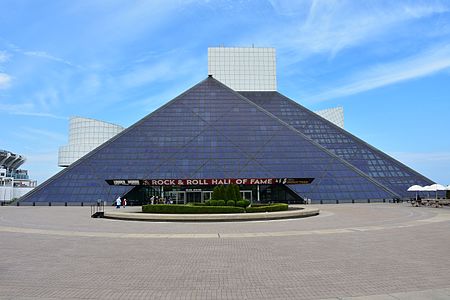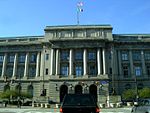Cleveland Stadium, commonly known as Municipal Stadium, Lakefront Stadium or Cleveland Municipal Stadium, was a multi-purpose stadium located in Cleveland, Ohio. It was one of the early multi-purpose stadiums, built to accommodate both baseball and football. The stadium opened in 1931 and is best known as the long-time home of the Cleveland Indians of Major League Baseball, from 1932 to 1993 (including 1932–1946 when games were split between League Park and Cleveland Stadium), and the Cleveland Browns of the National Football League (NFL), from 1946 to 1995, in addition to hosting other teams, other sports, and concerts. The stadium was a four-time host of the Major League Baseball All-Star Game, one of the host venues of the 1948 and 1954 World Series, and the site of the original Dawg Pound, Red Right 88, and The Drive.
Through most of its tenure as a baseball facility, the stadium was the largest in Major League Baseball by seating capacity, seating over 78,000 initially and over 74,000 in its final years. It was superseded only by the Los Angeles Memorial Coliseum from 1958 to 1961, while it was the temporary home of the Los Angeles Dodgers, and by Mile High Stadium in 1993, the temporary home of the expansion Colorado Rockies. For football, the stadium seated approximately 80,000 people, ranking as one of the larger seating capacities in the NFL.
Former Browns owner Art Modell took over control of the stadium from the city in the 1970s and while his organization made improvements to the facility, it continued to decline. The Indians played their final game at the stadium in October 1993 and moved to Jacobs Field (now Progressive Field) the following season. Although plans were announced to renovate the stadium for use by the Browns, in 1995 Modell announced his intentions to move the team to Baltimore citing the state of Cleveland Stadium as a major factor. The Browns played their final game at the stadium in December 1995, after which they were renamed the Baltimore Ravens. As part of an agreement between Modell, the city of Cleveland, and the NFL, the Browns were officially deactivated for three seasons and the city was required to construct a new stadium on the Cleveland Stadium site. Cleveland Stadium was demolished in 1996 to make way for Cleveland Browns Stadium (now FirstEnergy Stadium), which opened in 1999. Much of the debris from the demolition was placed in Lake Erie to create an artificial reef.












